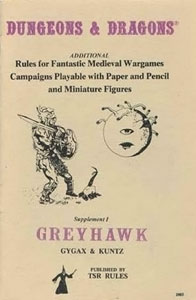
Ernest Gary Gygax was an American game designer and author best known for co-creating the pioneering tabletop role-playing game Dungeons & Dragons (D&D) with Dave Arneson.
Greyhawk, also known as the World of Greyhawk, is a fictional world designed as a campaign setting for the Dungeons & Dragons fantasy roleplaying game. Although not the first campaign world developed for Dungeons & Dragons—Dave Arneson's Blackmoor campaign predated it by about a year—the world of Greyhawk closely identified with early development of the game beginning in 1972, and after being published it remained associated with Dungeons & Dragons publications until 2008. The world itself started as a simple dungeon under a castle designed by Gary Gygax for the amusement of his children and friends, but it was rapidly expanded to include not only a complex multi-layered dungeon environment, but also the nearby city of Greyhawk, and eventually an entire world. In addition to the campaign world, which was published in several editions over twenty years, Greyhawk was also used as the setting for many adventures published in support of the game, as well as for RPGA's massively shared Living Greyhawk campaign from 2000 to 2008.
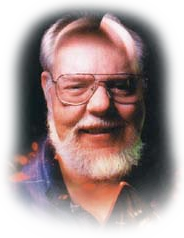
David Lance Arneson was an American game designer best known for co-developing the first published role-playing game (RPG), Dungeons & Dragons, with Gary Gygax, in the early 1970s. Arneson's early work was fundamental to the role-playing game (RPG) genre, pioneering devices now considered to be archetypical, such as cooperative play to develop a storyline instead of individual competitive play to "win" and adventuring in dungeon, town, and wilderness settings as presented by a neutral judge who doubles as the voice and consciousness of all characters aside from the player characters.

Blackmoor is a fantasy role-playing game campaign setting generally associated with the game Dungeons & Dragons. It originated in the early 1970s as the personal setting of Dave Arneson, the co-creator of Dungeons & Dragons, as an early testing ground for what would become D&D.

A gelatinous cube is a fictional monster from the Dungeons & Dragons fantasy role-playing game. It is described as a ten-foot cube of transparent gelatinous ooze, which is able to absorb and digest organic matter.

An owlbear is a fictional creature originally created for the Dungeons & Dragons fantasy role-playing game. An owlbear is depicted as a cross between a bear and an owl, which "hugs" like a bear and attacks with its beak. Inspired by a plastic toy made in Hong Kong, Gary Gygax created the owlbear and introduced the creature to the game in the 1975 Greyhawk supplement; the creature has since appeared in every subsequent edition of the game. Owlbears, or similar beasts, also appear in several other fantasy role-playing games, video games and other media.
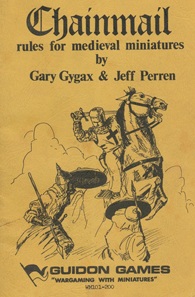
Chainmail is a medieval miniature wargame created by Gary Gygax and Jeff Perren. Gygax developed the core medieval system of the game by expanding on rules authored by his fellow Lake Geneva Tactical Studies Association (LGTSA) member Jeff Perren, a hobby-shop owner with whom he had become friendly. Guidon Games released the first edition of Chainmail in 1971.

Mordenkainen is a fictional wizard from the World of Greyhawk campaign setting for the Dungeons & Dragons roleplaying game. He was created by Gary Gygax as a player character, only months after the start of Gygax's Greyhawk campaign and is therefore one of the oldest characters continuously associated with Dungeons & Dragons.
In the World of Greyhawk campaign setting for the Dungeons & Dragons roleplaying game, Tenser is an archmage who strives to rid the Flanaess of evil. Tenser is a former member of both the Citadel of Eight and the Circle of Eight.
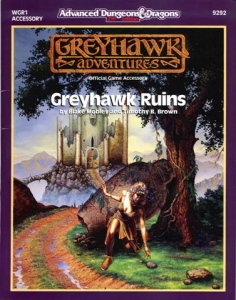
Castle Greyhawk is one of the central dungeon settings in the fictional World of Greyhawk campaign setting for the Dungeons & Dragons roleplaying game. The Castle was originally developed by Gary Gygax, for his own campaign and later detailed for publication. Castle Greyhawk is also the name of a 1988 Dungeons & Dragons adventure module that created a treatment of the Castle for the public to use. In 2005, Gygax announced the release of "Castle Zagyg," his new treatment of the dungeon.

Mordenkainen's Fantastic Adventure by Robert J. Kuntz and Gary Gygax is an adventure module for the Dungeons & Dragons role-playing game, published by TSR, Inc. in 1984. It originally bore the code "WG5" and was intended for use with the Advanced Dungeons & Dragons first edition rules. Because it is one of the WG modules, it is a module intended for the World of Greyhawk campaign setting. It was later updated in 2004 to the Third Edition Revised rules in Dungeon magazine, issue #112, as Maure Castle. There were subsequently two additional installments in issues #124 and #139.

Kobolds are a fictional race of humanoid creatures featured in the Dungeons & Dragons roleplaying game and other fantasy media. They are often depicted as small reptilian humanoids with long tails, distantly related to dragons.
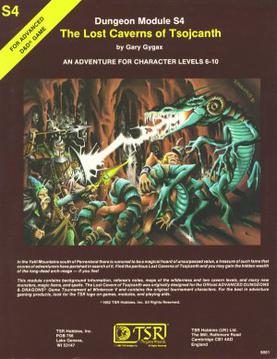
The Lost Caverns of Tsojcanth is an adventure module for the Dungeons & Dragons fantasy role-playing game. It was written by Gary Gygax and published by TSR in 1982 for the first edition Advanced Dungeons & Dragons (AD&D) rules. The 64-page adventure bears the code "S4" and is set in the Greyhawk campaign setting. It is divided into two parts, a 32-page adventure, and a 32-page booklet of monsters and magic items. The plot involves the player characters investigating rumors of lost treasure. After traversing a wilderness and two levels of dungeons, the players face Drelnza, the vampiric daughter of long-deceased archmage Iggwilv.

James Michael Ward III was an American game designer and fantasy author who worked for TSR, Inc. for more than 20 years, most notably on the role-playing game Dungeons & Dragons. He wrote various books relating to Dungeons & Dragons, including guidebooks such as Deities & Demigods, and novels including Pool of Radiance, based on the computer game of the same name.

Robert J. Kuntz is a game designer and author of role-playing game publications. He is best known for his contributions to various Dungeons & Dragons-related materials.
Donald R. Kaye was the co-founder of Tactical Studies Rules (TSR), the game publishing company best known for their Dungeons & Dragons (D&D) role-playing game. He and TSR co-founder Gary Gygax had been friends since childhood, sharing an interest in miniature war games. In 1972, Kaye created Murlynd, one of the first D&D characters, and play-tested him in Gygax's Castle Greyhawk campaign. Kaye and Gygax were convinced that D&D and similar games were an excellent business opportunity, and together they founded Tactical Studies Rules in 1973. However, only two years later, just as sales of D&D started to rise, Kaye unexpectedly died of a heart attack at age 36.

The original Dungeons & Dragons boxed set by Gary Gygax and Dave Arneson was published by Tactical Studies Rules in 1974. It included the original edition of the Dungeons & Dragons fantasy role-playing game. Its product designation was TSR 2002.

Blackmoor is a supplementary rulebook of the original edition of the Dungeons & Dragons fantasy role-playing game written by Dave Arneson.

Swords & Spells is a supplementary rulebook by Gary Gygax for the original edition of the Dungeons & Dragons fantasy role-playing game. Its product designation is TSR 2007.
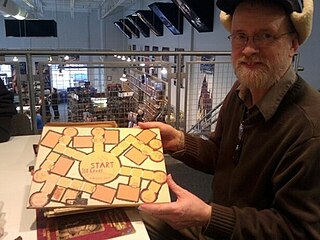
David R. Megarry is a game designer most notable for the board game Dungeon!.
